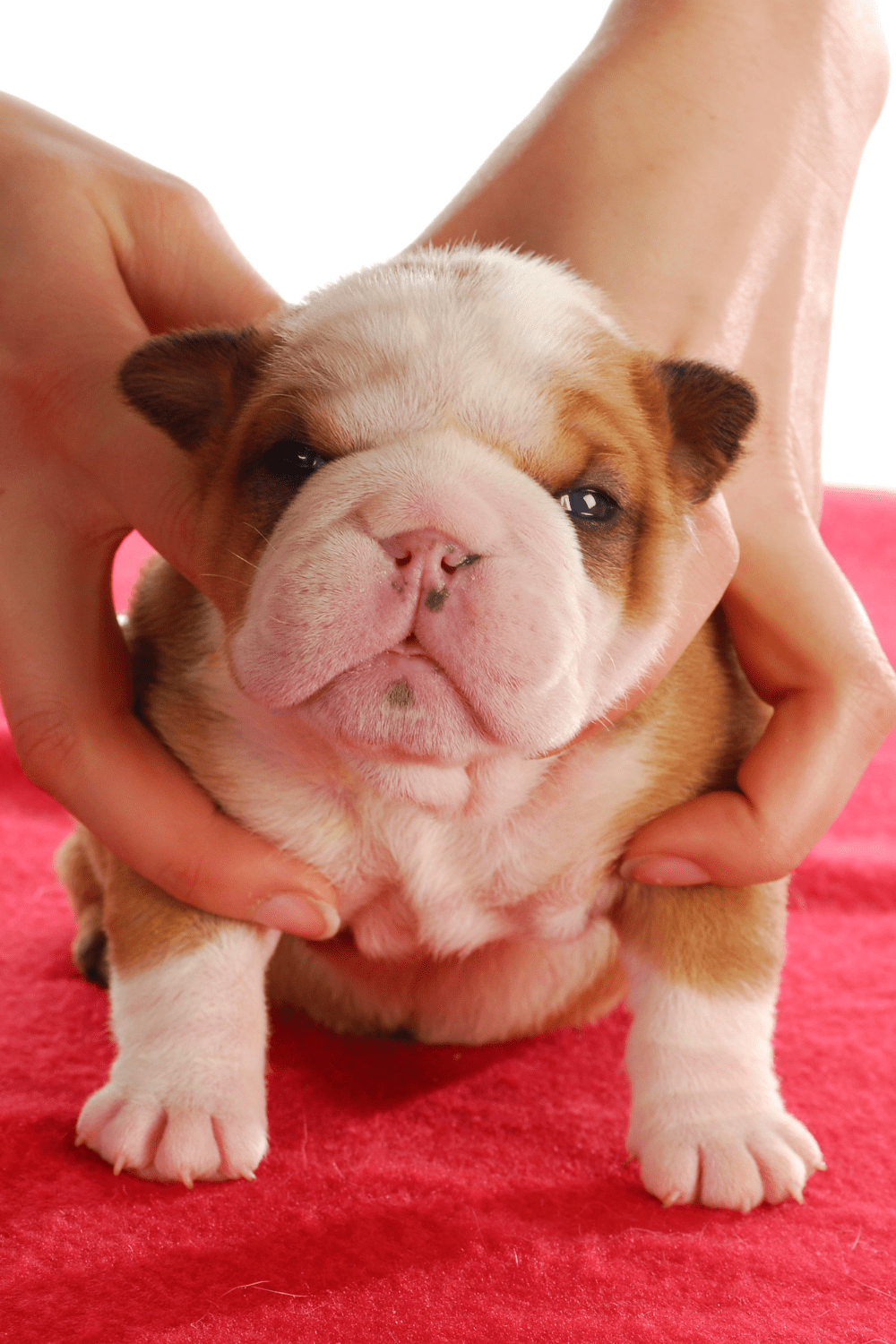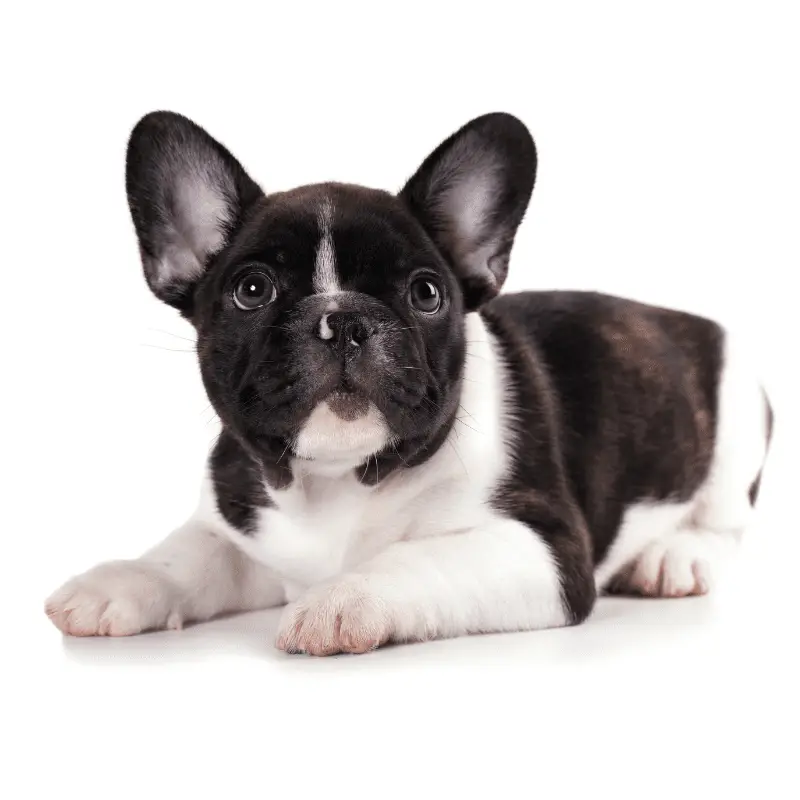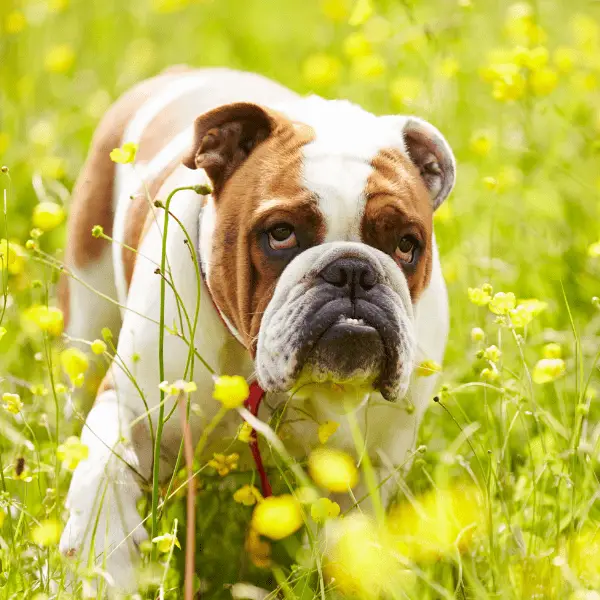Bulldogs are medium-sized dogs with distinctive pushed-in noses and wrinkled faces. The Bulldogs are also known as the British or the English Bulldog. The United Kennel Club, the American Kennel Club and The Kennel Club (UK) oversee the breeding records of the Bulldog. The sweet nature of bulldogs has made them one of the most popular pets worldwide. According to the American Kennel Club, these dogs were the fifth most popular purebred in 2017.
Even though these dogs are now widespread worldwide, they have an intricate relationship with English culture. During WWII, Prime Minister Winston Churchill’s defiance against Nazi Germany is often compared to the defiance of a Bulldog. When the English started moving to the United States, they brought Bulldogs. In England, the bulldog fans created the Bulldog Club in 1878. The bulldog club in America was formed in 1890.
Appearance
Bulldogs are a medium-sized breed of dog that typically weigh between 40-50 pounds. They have distinctive wrinkled faces with pushed-in noses and wide, square-shaped heads. Their ears are small and folded over, and their eyes are round and set low in their skull. Bulldogs have short, stocky bodies with thick necks and broad shoulders. Their short and smooth coat can come in various colours, including white, fawn, brindle, and black. Overall, bulldogs have a muscular and compact build that gives them a powerful appearance.








The breed standards in the United States are 55 lb (25 kg) for males and 50 lb (23 kg) for females. While in the United States, a mature male bulldog can weigh about 50 lb (23 kg), while adult females weigh about 40 lb (18 kg). According to the Bulldog Club of America, the average weight of the Bulldog should be between 40-50 lb.
The tail of the bulldog is generally short. They come in either screwed or straight shapes. The thickness of the tail varies from one dog to the next. As the tail of the Bulldog is naturally short, they are not docked like the tails of dogs of other breeds. According to the standards of BCA, a straight tail is desired if it is facing downwards.
Temperament
According to the American Kennel Club, the disposition of bulldogs are kind and equitable. These dogs should be courageous, persistent, and not overly aggressive or vicious. The demeanour of the dogs should be dignified and pacifist. The expression, as well as the behaviour of the dog, should exhibit all the above attributes.
Over the years, the breeders have worked hard to reduce the aggressiveness of these dogs. The modern breed of bulldogs is patient and friendly but slightly stubborn. However, these dogs can create strong bonds with the kids, making bulldogs one of the most popular household pets.
History Timeline
1631-32
The first reference to bulldogs can be found as early as 1631-32. During that time, Preswick Eaton wrote a letter about bulldogs.
1666
In 1666, the English Scientist Christopher Merret created an entry in his Pinax Naturalium Britannicarum as ‘Canis Pugnux, a Butchers Bull or Bear Dog’. The bull portion of the name of the Bulldog came from the fact that these dogs were used in bull baiting. In that game, these dogs were set off onto a tethered bull. The dog that grabbed the bull by its nose and pinned it to the ground was considered the winner. People used to place bets on the dogs as it was common for the bulls to maim or kill them.
Over centuries, the body type of these bull-baiting dogs changed. The dogs became stockier, with more oversized heads and protruding jaws. The nature of the dogs changed as well. They became more ferocious and developed a savage temperament.
1835
The Cruelty to Animal Act of 1835 brought profound changes that stopped the games like bull-baiting and bear-baiting. This act protected some animals, such as dogs, snakes, owls, and donkeys, from mistreatment and cruelty. The same law also prohibited cockfighting.
In this way, the old bulldogs have outlived their purpose in the sporting market, and their workdays become numbered. However, the emigrants found some usefulness in these ferocious dogs.
1878-86
The Bulldog Club of England is the oldest single breed speciality club, formed in 1878. The club members wrote the first standard of perfection for the breed of Bulldog. The American Kennel Club officially recognized the Bulldog in 1886.
19th Century
In the mid-19th century, the Governor of Newyork, Richard Nicolls, used the bulldogs as a part of the city-wide round-up efforts of the wild bulls. As cornering the wild bulls and leading them up was dangerous, the Bulldogs were trained to seize the bulls by their nose just long enough to secure the rope around their neck.
While the work scope of the bulldogs was shrinking, the pet dealers of the Victorian era were continuously promoting these dogs as family pets.
Even though the maturation age of these dogs is slow, they show early signs of old age. Bulldogs five to six years of age can show signs of ageing.
Modern Day
While the modern Bulldog has retained the same stocky physical shape, it can no longer withstand the rigours of running. Even though their physical features have not seen much change, the bulldogs’ temperament has greatly changed in the past few years. The bulldogs’ decreased aggression has made them better family pets.
Health
The leading cause of death of bulldogs is cardiac arrest. About 20% of all bulldog deaths happen due to cardiac arrest. The other causes of death of bulldogs are cancer and old age. A survey conducted in the UK in 2004 found that the median death age of bulldogs is six years and three months. Those dogs that die of old age can live up to 10 to 11 years.
The Orthopaedic Foundation for Animals conducted a longitudinal study of bulldogs for 30 years. According to the survey, about 73.9% of bulldogs suffered from hip dysplasia, the highest among all other breeds. Also, Patellar Luxation affects about 6.2% of bulldogs.
Some bulldogs suffer from cysts formed between the toes. Even though these cysts are uncomfortable for dogs, they are easily treatable. You can take the dog to a vet, or if you are experienced, you can treat it yourself.
The dogs can also suffer from respiratory problems. Other common issues are cherry eye, hip issues and allergies.
As the puppies’ large heads can get stuck into the mother’s birth canal, about 80% of Bulldog litters are delivered through caesarean section.
If you are an owner, you should clean the skin folds on the face of the Bulldog regularly. This step will help you avoid problems of infection. Sometimes the curling tails of the bulldogs also need the owner’s attention. Due to the high number of folds on the Bulldog’s body, they are vulnerable to skin-fold dermatitis.
Like all other breeds of dogs, bulldogs also require regular exercise. If the dogs do not get proper training, they can become overweight, quickly leading to lung and heart diseases.
The bulldog breeds often suffer from brachycephalic airway obstructive syndrome. This condition manifests in different ways. More often than not, it makes the dogs intolerant of physical exertion and heat. The small nasal passages of bulldogs make it difficult for them to keep their bodies cool.
That means you have to practice extra caution during the summer months. Make sure your bulldogs stay out of the standing heat. Offer lots of water and keep it under the shade even when venturing outside. Adequate ventilation and air conditioning are required to keep them healthy and safe. As these dogs do most of their sweating through the pads on their feet, they enjoy the coolness of the floor. Staying aware of your dog’s issues will help you keep your pet from unsafe conditions.

As a Mascot
The Bulldog is often a famous representative mascot of England or the UK. The defiance of Winston Churchill during World War II is often compared with the nature of bulldogs. The Bulldog is also the official mascot of the United States Marine Corps. Thirty-nine different universities across the United States also use Bulldog as their mascots.
Conclusion
All in all, owning a bulldog may not be the most straightforward task you take up. But try to be optimistic; these affectionate mush balls can change your life. Stay away from all the negative thoughts and presumptions most people have about bulldogs. Bulldogs are the keepers, and they are the most excellent family additions. So, follow your heart, and give a cuddly bulldog a home.
